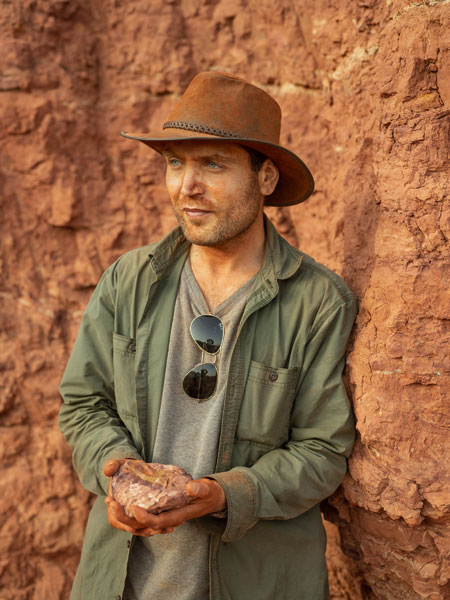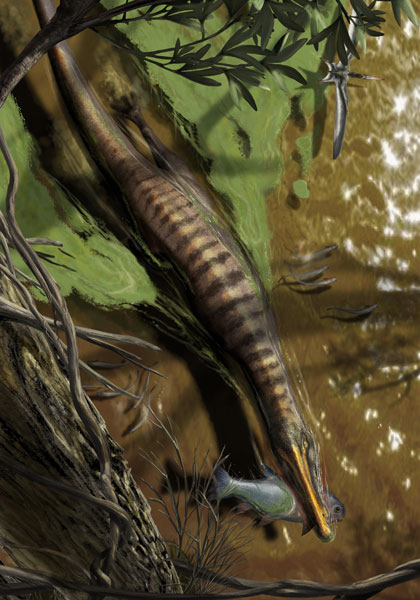Spinosaurus (S. aegyptiacus) and its close relatives (spinosaurids) are an enigmatic group of theropod dinosaurs that have undergone a radical shift in their place in Early to early Late Cretaceous ecosystems as more evidence has emerged that these predators were adapted to a semi-aquatic lifestyle.
This week, in the journal “Nature”, a new study was published reinforcing the idea that these dinosaurs were perfectly at home in the water. An examination of spinosaurid bone density in comparison to the bone densities of extant animals which are adapted to an aquatic life, demonstrates that Spinosaurus and its close relative Baryonyx (B. walkeri) were capable of submerging themselves underwater to hunt.

Spinosaurus, the longest predatory dinosaur known, is opening its elongate jaws, studded with conical teeth, to catch a sawskate. Contrary to previous suggestions, this animal was not a heron-like wader – it was a “river monster”, actively pursuing prey in a vast river system located in modern-day North Africa. Dense bones in the skeleton of Spinosaurus strongly suggest it spent a substantial amount of time submerged in the water. Picture credit: Davide Bonadonna.
Picture credit: David Bonadonna
Anatomical Adaptations for an Aquatic Life
Recent studies utilising fossil finds from North Africa had demonstrated that Spinosaurus aegyptiacus possessed a number of anatomical adaptations indicating an aquatic existence. It had long, narrow jaws lined with cone-shaped teeth, ideal for catching slippery fish. The nostrils were retracted and located further up the snout, Spinosaurus was a quadruped with short hind legs adapted for swimming and it is now known that it had a fin on its long tail, making it ideal as an organ for propulsion: Spinosaurus a River Monster!
When Baryonyx was first described after the discovery of its fossilised bones in a Surrey clay pit, scientists found evidence of fish scales and the remains of a small iguanodontid in the body cavity where the stomach would have been. This suggests that Baryonyx ate fish as well as other dinosaurs.
Dr Nizar Ibrahim
University of Portsmouth palaeontologist Dr Nizar Ibrahim has been at the forefront of research into spinosaurids, helping to change our perceptions about these super-sized predators. He has been a member of several field teams that have explored the Cretaceous deposits of North Africa helping to find more fossils of Spinosaurus aegyptiacus upon which these new revelations are based.

Dr Nizar Ibrahim in the Sahara. A co-author of the scientific paper that examined bone density of living animals comparing these results to those of spinosaurids to further strengthen the theory that dinosaurs such as Baryonyx and Spinosaurus were semi-aquatic. Picture credit: Paolo Verzone.
Picture credit: Paolo Verzone
Dr Ibrahim is one of the co-authors of the bone density paper. The continuing debate about just how much time Spinosaurus spent in the water and whether it was an underwater pursuit predator or hunted fish like a giant heron led lead author Dr Matteo Fabbri, (Chicago Field Museum), senior author Dr Ibrahim and international colleagues to try to find another way to infer the lifestyle and ecology of Spinosaurus.
Dr Fabbri explained:
“The idea for our study was, okay, clearly we can interpret the fossil data in different ways. But what about the general physical laws? There are certain laws that are applicable to any organism on this planet. One of these laws regards density and the capability of submerging into water.”
Bone density can provide evidence to support a vertebrate’s aquatic behaviour. Animals that spend a lot of time underwater tend to have dense bones to help them remain submerged. If spinosaurids had similar bones, then this would provide further evidence in support of the idea that these dinosaurs hunted underwater.
Bone Densities of Living and Extinct Animals Compared
The research team assembled an exceptionally large dataset of femur and rib bone cross-sections from 250 species of extinct and living animals, including both land-dwellers and water-dwellers, and covering animals ranging in weight from a few grammes to several tonnes including seals, whales, elephants, mice, and even hummingbirds.
The scientists also collected data on extinct marine reptiles like mosasaurs and plesiosaurs. The researchers compared bone cross sections of these animals to cross-sections of bone from Spinosaurus and its close relatives Baryonyx and Suchomimus.
A clear link was identified between bone density and aquatic foraging behaviour. Animals that submerge themselves underwater to find food have bones that are almost completely solid throughout, whereas cross-sections of land-dwellers’ bones look more like doughnuts, with hollow centres.
When the researchers applied spinosaurid dinosaur bones to this paradigm, they found that Spinosaurus and Baryonyx both had the type of dense bone associated with full submersion.

Baryonyx, from Surrey in England, swims through an ancient river with a fish in its jaws. Like its much larger African relative Spinosaurus, Baryonyx had dense bones, suggesting that it too spent much of its time submerged in water. It was previously thought to have been less aquatic than its Saharan relative. Picture credit: Davide Bonadonna.
Picture credit: Davide Bonadonna
Commenting on their research Dr Ibrahim stated:
“The scope of our study kept expanding because we kept thinking of more and more groups of vertebrates to include.”
A Different Environmental Niche for Suchomimus
The closely related Suchomimus (S. tenerensis), fossils of which are known from the Early Cretaceous of Niger, was discovered to have less dense bones than both Baryonyx and Spinosaurus. It lived by water and ate fish, as evidenced by its crocodile-like snout and conical teeth, but based on its bone density, it wasn’t actually swimming much. Perhaps this dinosaur was not a subaqueous forager but hunted for fish by wading into the water, rarely getting out of its depth.
Picture credit: Everything Dinosaur
Different feeding behaviours might help to explain why similar types of spinosaurid could co-exist: Two New Spinosaurids from the Isle of Wight.
Spinosaurids were Semi-Aquatic
Co-author of the study, Dr Jingmai O’Connor from the Field Museum in Chicago explained that collaborative studies like this one that draw from hundreds of specimens, are “the future of palaeontology”. These studies might be very time-consuming to complete, but they let scientists shed light onto big patterns within the fossil record.
Dr Ibrahim is already thinking about his next research project, he commented:
“I think that, with this additional line of evidence, speculative notions that envisage Spinosaurus as some sort of giant wader lack evidential support and can be safely excluded. The bones don’t lie, and now we know that even the internal architecture of the bones is entirely consistent with our interpretation of this animal as a giant predator hunting fish in vast rivers, using its paddle-like tail for propulsion. It will be interesting to reconstruct in a lot more detail how these river monsters moved around – something we are already working on.”
Everything Dinosaur acknowledges the assistance of a media release from the University of Portsmouth in the compilation of this article.
The scientific paper: “Subaqueous foraging among carnivorous dinosaurs” by Matteo Fabbri, Guillermo Navalón, Roger B. J. Benson, Diego Pol, Jingmai O’Connor, Bhart-Anjan S. Bhullar, Gregory M. Erickson, Mark A. Norell, Andrew Orkney, Matthew C. Lamanna, Samir Zouhri, Justine Becker, Amanda Emke, Cristiano Dal Sasso, Gabriele Bindellini, Simone Maganuco, Marco Auditore and Nizar Ibrahim published in Nature.
Visit Everything Dinosaur’s website: Everything Dinosaur.







Leave A Comment